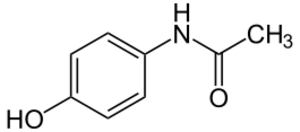Paracetamol facts for kids
Paracetamol (also called acetaminophen) is a very common medicine. It helps to make pain go away. It can also lower a fever, which is when your body temperature is too high. Because it lowers fevers, it is known as an antipyretic. You can find paracetamol in many medicines used for the flu and colds.
The names acetaminophen and paracetamol come from the chemical names of the ingredients. Sometimes, people shorten it to APAP.
A scientist named Harmon Northrop Morse first made paracetamol in 1878. Medicines with paracetamol became popular in the 1950s. Today, these medicines are among the most used, along with those containing salicylic acid or Ibuprofen. In 1977, the WHO added paracetamol to its List of Essential Medicines. This list includes the most important medicines needed in a basic health system.
Contents
Medical Uses of Paracetamol
Paracetamol is a helpful medicine for different health issues. It mainly works to reduce pain and lower fevers.
For Fevers
Paracetamol is used to lower fevers for people of all ages. The World Health Organization suggests giving paracetamol to children only if their temperature is higher than 38.5°C (101.3°F). Some studies have shown that ibuprofen might be more effective than paracetamol for fevers in children. Paracetamol does not reduce swelling or redness in the body.
For Pain Relief
Paracetamol helps with mild to moderate pain. Doctors sometimes use it through an IV (into a vein) for quick pain relief in emergencies.
Joint Pain (Osteoarthritis)
The American College of Rheumatology suggests paracetamol as an option for people with joint pain from arthritis. This is for pain in the hip, hand, or knee that doesn't get better with exercise or losing weight. However, one study in 2015 found it only helped a little with osteoarthritis.
Unlike other pain medicines like aspirin or ibuprofen, paracetamol does not reduce swelling. It can help with pain from mild arthritis. But it does not fix the swelling or redness in the joint. Paracetamol is similar to aspirin for pain relief. But it is usually easier on the stomach than aspirin.
Back Pain
Some medical groups, like the American Pain Society, suggest paracetamol as a first choice for lower back pain. Other groups, like the American College of Physicians, found that other medicines like NSAIDs work better. Some studies even say there isn't enough proof that paracetamol helps with back pain.
Headaches
Doctors in Germany, Austria, and Switzerland recommend paracetamol mixed with caffeine for tension headaches and migraines. For a sudden migraine, paracetamol works better than no medicine at all. About 39% of people felt better after one hour with paracetamol, compared to 20% who took no medicine.
Pain After Surgery
When paracetamol is taken with other medicines called NSAIDs, it can be more effective for pain after surgery. This combination works better than taking either medicine alone.
Tooth Pain
NSAIDs like ibuprofen are often better than paracetamol for tooth pain. However, a mix of NSAIDs and paracetamol works even better. Paracetamol is very useful if someone cannot take NSAIDs. This might be due to allergies or stomach problems. It can also be used with NSAIDs if they are not enough on their own. One study found that taking paracetamol before dental work did not help reduce pain afterward for children.
Other Pain Conditions
Taking paracetamol with caffeine can help more with common types of pain. This includes tooth pain, pain after childbirth, and headaches.
Images for kids
-
Julius Axelrod (pictured) and Bernard Brodie showed that other medicines turn into paracetamol in the body.
See also
 In Spanish: Paracetamol para niños
In Spanish: Paracetamol para niños






